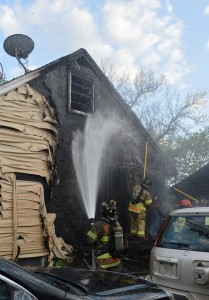A home fire is a traumatic experience, and in its destructive wake it can be difficult to gauge your first move. But you don’t have to face it alone. With help from your homeowners insurance company and restoration services — as well as family, friends, and neighbors — there’s no reason rebuilding after a fire can’t be done. Here we’ve outlined 5 steps to help you quickly get your life back on track.
1. contact your homeowners insurance company
According to the National Fire Protection Association, civilian fires resulted in $14.3 billion in property damage in 2015. And luckily, fires are typically covered by a standard homeowners insurance policy. An Esurance policy, for instance, extends personal property coverage to replace damaged belongings, and dwelling protection to help pay for repairs to your house. Plus, you’ll get $500 worth of protection to help cover fire department charges — a limit you can increase at any time.
That said, your first move should be contacting your home insurance company. They will work with you to gauge your best options and help you find a reputable fire restoration service. Because your insurer specializes in these situations, they’re likely to know of services that’ll best align with your current needs. Plus, companies referred by your insurer are more likely to have solid connections with top-quality contractors, engineers, and architects who can better ensure your home is successfully restored.
2. find out when it’s safe to go back into the house
It’s important that you don’t re-enter your home, or any surrounding structure, that’s been affected by the fire until permitted by local building officials or the fire department. Not only can fires erupt again, but there’s almost always hidden damage that could render the home unsafe. Open doors carefully, and don’t force them open if they’re jammed because you run the risk of further structural damage or collapse. Any remaining soot, debris, and dirty water could make you sick too, so use extra precaution when going back into your home, especially if you touch damaged items.
If you are permitted to go back into your home, be sure to wear long pants, a shirt with long sleeves, work gloves, and shoes or boots with rubber soles. It might also be a good idea to wear safety goggles, a hard hat, or other safety equipment. If you smell gaseous odors, contact the fire department immediately.
3. create a list of all damaged items
When you make a fire damage insurance claim, you’ll likely need to submit an inventory list of all damaged personal property to your home insurance company. This will require you to begin separating the damaged and undamaged items. It’s important to note, though, that having a detailed list of all your possessions already on hand will alleviate a difficult process and help settle the claim much faster.
This list should include the brand name, receipts, purchase price, serial number, and the description of each item. If you don’t have copies of the receipts, or if they were destroyed in the fire, make sure to get copies of your previous bank statements.
Any belongings that aren’t damaged should be kept in storage. Most homeowners insurance companies will help cover storage costs if the home is rendered uninhabitable — but more on that later.
4. get a copy of the fire report
A fire report provides the date and time of the incident, the area affected, a description of the damage, and the ignition source of the fire (if discovered). It allows fire departments to know all the specifics surrounding the event, such as who was there and the resources that were available, enabling them to gather further information. Plus, fire reports could be helpful in regards to information requested by your insurer.
Depending on where you live, fire reports are typically considered public documents and you can ask for them at the fire department or marshal’s office. If arson was involved, your local task force specializing in arson cases can likely get this information to you.
5. make sure you have somewhere to stay
Most homeowners insurance companies include additional living expense coverage (ALE). If your home is rendered unlivable due to a fire or any other covered disaster, ALE could help pay for temporary housing, increased food costs, pet boarding, and storage space. Bear in mind, this coverage is meant to maintain equivalent living standards, so if you live in a 2-bedroom home, then your insurer probably won’t help put you up in a 6-bedroom palace.
protect your home and belongings with reliable homeowners insurance
It goes without saying that house fires can be devastating in more ways than one — not to mention they’re the most costly of homeowners insurance claims. So even if you’ve been thorough about reducing your risk and avoiding obvious fire hazards, there’s still far too much to lose by not being financially protected.
763-439-2513

